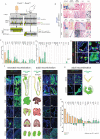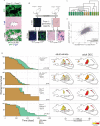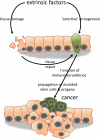Multi-organ Mapping of Cancer Risk
- PMID: 27565343
- PMCID: PMC5067024
- DOI: 10.1016/j.cell.2016.07.045
Multi-organ Mapping of Cancer Risk
Abstract
Cancers are distributed unevenly across the body, but the importance of cell intrinsic factors such as stem cell function in determining organ cancer risk is unknown. Therefore, we used Cre-recombination of conditional lineage tracing, oncogene, and tumor suppressor alleles to define populations of stem and non-stem cells in mouse organs and test their life-long susceptibility to tumorigenesis. We show that tumor incidence is determined by the life-long generative capacity of mutated cells. This relationship held true in the presence of multiple genotypes and regardless of developmental stage, strongly supporting the notion that stem cells dictate organ cancer risk. Using the liver as a model system, we further show that damage-induced activation of stem cell function markedly increases cancer risk. Therefore, we propose that a combination of stem cell mutagenesis and extrinsic factors that enhance the proliferation of these cell populations, creates a "perfect storm" that ultimately determines organ cancer risk. VIDEO ABSTRACT.
Copyright © 2016 Elsevier Inc. All rights reserved.
Figures







Comment in
-
Tell me about your stemness. I'll give your cancer risk!Cell Death Differ. 2017 Jan;24(1):6-7. doi: 10.1038/cdd.2016.144. Epub 2016 Dec 9. Cell Death Differ. 2017. PMID: 27935585 Free PMC article. No abstract available.
References
-
- Arndt K, Grinenko T, Mende N, Reichert D, Portz M, Ripich T, Carmeliet P, Corbeil D, Waskow C. CD133 is a modifier of hematopoietic progenitor frequencies but is dispensable for the maintenance of mouse hematopoietic stem cells. Proceedings of the National Academy of Sciences. 2013;110:5582–5587. - PMC - PubMed
-
- Ashford NA, Bauman P, Brown HS, Clapp RW, Finkel AM, Gee D, Hattis DB, Martuzzi M, Sasco AJ, Sass JB. Cancer risk: role of environment. Science. 2015;347:727. - PubMed
-
- Barker N, Huch M, Kujala P, van de Wetering M, Snippert HJ, van Es JH, Sato T, Stange DE, Begthel H, van den Born M, et al. Lgr5+ve Stem Cells Drive Self-Renewal in the Stomach and Build Long-Lived Gastric Units In Vitro. Cell Stem Cell. 2010;6:25–36. - PubMed
-
- Bienz M, Clevers H. Linking colorectal cancer to Wnt signaling. Cell. 2000;103:311–320. - PubMed
Publication types
MeSH terms
Substances
Grants and funding
LinkOut - more resources
Full Text Sources
Other Literature Sources
Medical
Molecular Biology Databases

